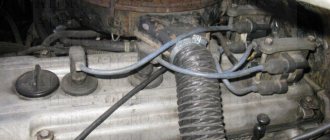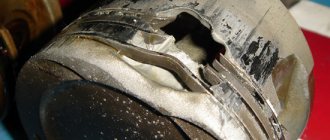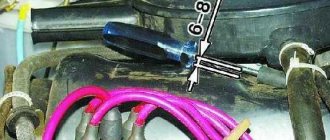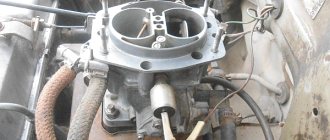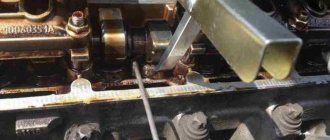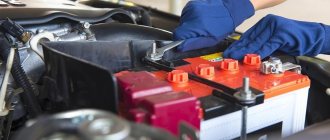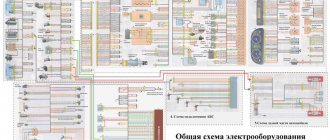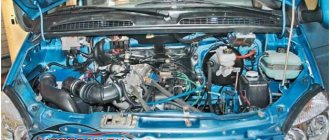Signs of a malfunctioning knock sensor. Check and replace at home. (Part 1)
Good day, friends.
I was often asked questions about this device, so in today’s article I would like to answer you the most frequently asked questions about this. After all, many car owners believe that a malfunction of the knock sensor does not interfere with the operation of the engine in any way, and in some ways they are right, but as always there is one BUT - over time, this malfunction will lead to the failure of other systems and mechanisms of this circuit. And this is much more waste on repairs than checking and, if necessary, replacing the knock sensor. But not everyone knows that in order to check and replace it is not necessary to go to a service center and ask for help from specialists, who most often have a level of knowledge in this area equal to yours and, in fact, will do a not so difficult job for which they will demand a tidy sum from you (I am now I don’t want to make anyone look stupid, it just happened to me personally in life). So, I just want to convey to people that all these procedures with a sensor are done very simply and do not require huge investments and waste of time. The main thing in this matter: 1) Perseverance; 2) Attentiveness; 3) Accuracy; 4) Well, hands from the place that God gave us)
Well, let's start with the basics.
What is a knock sensor? But here everything is simple - this is a part (part) of the control system that is responsible for controlling the level of detonation. Where can I find it? Everything is easy here too - we look on the engine cylinder block. Friends, just don’t get confused and don’t look for it on carburetor engines
. This sensor is installed on injection-type gasoline engines (where there is an electronic ignition system) and specifically on the engine body. The size of this part (if anyone hasn’t seen it) is literally proportional to the size of a matchbox.
It should also be noted that thanks to this device it becomes possible to save fuel
and the ability of the motor
to develop maximum power. The knock sensor regulates the vehicle's starting system and its operation.
In modern cars, as you know, you can see the operation of the sensor on the instrument panel and if there is a malfunction, the indicator will let you know about it.
(CHECK)
So, let’s now look at the operating principle of this device.
It consists of a piezoelectric mechanism (there is a plate inside that has a piezoelectric effect). So, when that same detonation occurs, voltage appears at the output and input. The result is engine vibration. A so-called potential difference is created, in which the voltage level at one end exceeds the level at the other. The sensor, in turn, “is engaged” in adjusting this process.
If for some reason the sensor fails, the “
Check ” indicator lights up on the instrument panel.
Conclusion - immediate repair or replacement of the sensor itself is necessary.
Video on the topic
In a gasoline internal combustion engine, under certain circumstances, a metallic knock occurs. “Fingers are knocking,” some drivers say. In fact, this phenomenon is called detonation and its occurrence is extremely undesirable, since it can lead to engine failure due to the enormous speed of propagation of the flame front (more than 2000 m/s) and high shock loads on the cylinder walls, piston and block head. To monitor the level of danger, a knock sensor is installed on the cylinder block.
It is an accelerometer, that is, a device that perceives and converts the energy of mechanical vibrations of the cylinder block into electrical impulses. The knock sensor continuously sends signals to the electronic engine control unit, and the electronics respond by changing the qualitative composition of the working mixture and the ignition timing. This device also helps to achieve more economical operation and develop maximum engine power.
What determines the likelihood of detonation? How often this phenomenon can occur depends on three main factors.
First of all, the likelihood of occurrence is affected by the chemical composition of gasoline, or more precisely, its octane number. The higher it is, the more resistant it is to this phenomenon. The second factor, which influences no less, is the design features of the engine, namely the compression ratio, the shape of the combustion chamber, the location of the spark plugs, the shape of the piston crown, etc. For example, an engine with a higher compression ratio is more prone to detonation and requires high-octane gasoline. Otherwise, why do manufacturers write the minimum permissible octane number on the gas tank hatch? The third factor is the operating conditions of the motor. The likelihood of detonation is affected by the composition of the working mixture, load, selected gear, and carbon deposits. How does a knock sensor work? The operating principle of the sensor is based on the piezoelectric effect. This device is a piezoelectric plate placed in a housing, at the ends of which, in the event of detonation, voltage appears. With increasing amplitude and frequency of mechanical vibrations of the engine, the voltage increases.
knock sensor device
There is a certain safety threshold; if the voltage exceeds it, the electronic control unit will give a command to reduce the ignition timing.
Failure of the knock sensor If a malfunction of the knock sensor occurs, the control indicator on the dashboard lights up. The engine is still running and you can drive the car. To the logical question “why is this sensor needed then?” the answer is as follows.
On older cars not equipped with an electronic control unit, the ignition timing was adjusted manually by turning the ignition distributor cap. This made it possible to adjust the operation of the ignition system depending on the octane number of gasoline, which can vary greatly at different gas stations. A modern engine has a different distributor design; its cover is fixed, so this function is performed by the ECU. Accordingly, if the knock sensor fails, the ignition timing cannot be adjusted.
A failed knock sensor affects the dynamics and efficiency of the engine. The operating principle of the electronic control unit is such that if a sensor malfunction occurs, it sets the ignition deliberately later for safety purposes in order to eliminate the possibility of engine destruction. As a result, the power unit works, but begins to consume much more fuel, and the dynamics of the car deteriorate. The second is especially noticeable at increased loads.
Checking the knock sensor The main symptoms indicating that this device has failed:
power drop; deterioration in acceleration characteristics and a sharp increase in the “appetite” of the engine; smoky exhaust. At the same time, the engine malfunction indicator on the panel lights up. Moreover, it can either burn constantly or light up briefly when the load increases.
how to check the sensor
It is not always possible to have a scanner at hand that can read and decipher the fault code. Getting to the service station is also not always possible. The question arises: how to check the knock sensor yourself? The tools you need are a digital multimeter.
First of all, it is necessary to find out what resistance a working sensor should have on a specific car or engine model, since this value is different for all manufacturers. If it is different from normal, a replacement is needed.
You can also check the voltage at the sensor's electrical contacts by disconnecting the sensor's electrical power connector and removing it from the engine. After this, the multimeter is switched to the voltage measurement mode in millivolts, its positive probe is connected to the signal contact, and the negative probe is connected to the sensor ground (the hole through which the engine mounting bolt passes).
Checking the knock sensor involves holding the sensor with the attached probes in the palm of your hand, which you then need to lightly tap on some surface. When impacted, the multimeter should detect the appearance of voltage (usually it is about 30-40 mV). The principle is simple: the stronger the impact, the greater the potential difference will arise between the electrodes. Since the voltage is low, not every device is capable of measuring it, so you must first make sure that the measuring device at hand is designed for such measurements. A complete absence of potential difference indicates that the knock sensor is faulty.
The occurrence of metallic knocking in Zhiguli engines running on gasoline is considered a common occurrence. Inexperienced drivers think that the problem is related to the “fingers”. However, almost always the cause lies in detonation. Such signs can become harbingers of big problems, which do not exclude engine failures. Everything is easily explained - the engine is not able to withstand the loads that begin to act on the pistons and cylinders.
Content:
Symptoms of a knock sensor failure.
Hello. Today I wanted to talk about the knock sensor and the symptoms of its failure. Using the example of VAZ family cars.
The knock sensor is an important element of modern engine management systems. In carburetor systems, the ignition angle was changed by adjusting (turning) the distributor. In injection systems, the adjustment is controlled electronically.
On engines of the VAZ family, the knock sensor (DS) is installed on the cylinder block between the 2nd and 3rd cylinders.
The operation of the sensor is based on the piezoelectric effect. From mechanical impact, the sensor begins to generate voltage. The sensor is located in the place of greatest heating, from where the spread of detonation combustion begins. The sensor is configured to perceive noise with a frequency of 25-75 Hz.
As written above, from the influence of mechanical impulses, the knock sensor begins to generate voltage, which is supplied to the electronic engine control unit (ECU).
If the voltage exceeds the critical value, the electronic unit, after processing the signal, adjusts the ignition angle, making it late. The system then optimizes fuel injection. This allows you to achieve efficiency and maintain the intended engine power.
If the knock sensor fails, the engine malfunction lamp comes on. The following errors may occur: "Open knock sensor", "Low noise level". If there is increased noise during engine operation, the following error message may appear: “High noise level.” If the sensor fails, you can continue driving, the car will not stop. But the following symptoms and consequences should be noted:
- Loss of engine power;
- Deterioration of throttle response;
- Increased fuel consumption.
We check the condition of the connector and wires leading to the sensor. If everything is fine with them, we change the sensor.
It should be noted that a quality knock sensor is not easy to find. There were even dummies: there was no piezoelectric element inside the sensor. The contacts were just sticking out in the plastic. I buy knock sensors from the Autocom manufacturer.
Not an advertisement. You'll just save time. But even here there are already fakes.
Source
Purpose
p, blockquote 14,0,1,0,0 —>
The main purpose of the knock sensor is to detect the onset of this harmful effect in time and transmit information to the electronic engine control unit to adjust the quality of the gasoline-air mixture and the ignition angle to prevent dangerous engine knocking.
p, blockquote 15,0,0,0,0 —>
Video - what DD is:
p, blockquote 16,0,0,0,0 —>
p, blockquote 17,0,0,0,0 —>
The fact of this effect is registered by converting the mechanical vibrations of the engine into an electrical signal.
p, blockquote 18,0,0,0,0 —>
What is a knock sensor and why is it needed?
This part is found in cars that use gasoline as fuel. It is intended for injection types of engines. The sensor is located on the engine cylinder block. This is an important part of the control system, the main purpose of which is to control the level of detonation.
In answering the question of what the knock sensor is responsible for , it should be noted that thanks to it the following vehicle capabilities are realized:
- Fuel economy.
- The ability of the engine to develop maximum power.
The sensor monitors the vehicle's starting system and regulates its proper operation.
What are the main components of a knock sensor?
The main details of this mechanism are:
- Vibrating plate.
- Piezo type electrical element.
- Signal wire.
- Braid.
Where is the knock sensor located?
Depending on the make of the car, the location of the sensor may vary, but it is always located on the engine body. The part itself is very small, about the size of a matchbox.
Part installation features
An important feature of installing the sensor is the presence of an electronic ignition system in the car. If it is not there, then there is no sensor. Older models do not have a knock sensor. It is also not installed on carburetor engine systems.
Replacing the sensor on a VAZ, video:
Checking DD yourself
The knock sensor is located between cylinders 2 and 3 on the radiator side directly on the engine block. Checking the knock sensor is a simple matter, especially if you have ever looked under the hood of the fourteenth.
Replacing the knock sensor VAZ 2114
- The key end is 13 for a single-pin DD (resonant) and 22 for a two-pin DD (broadband)
- Simple screwdriver
- Multimeter
How to check the knock sensor
The first thing to do is remove the DD. It’s easier to remove the single-pin one: don’t touch the ignition, turn it off and unscrew the sensor from the engine. The two-pin one is more complicated: we also don’t touch the ignition, but we also need to remove the negative from the battery. Then, remove the wires of the block, unscrew the DD fastening and remove it.
Second, we switched the multimeter to a voltmeter and set the limit to 200 MV. We connected it to the DD and carefully hit it with some piece of iron (the same screwdriver). When impacted, the voltage should jump; if there is no jump, the sensor is dead, go to the store for shopping.
When a two-pin DD is connected, its terminals cling to the multimeter, when a single-contact DD is connected, one contact and its body are clinging.
Third, we look at the wiring, as already mentioned, most often it’s a matter of frost, or broken contacts.
A simple plan on how to check the knock sensor in your garage with properly trained hands.
Opinions agree that a non-working DD should not be replaced with an analogue from the factory. You will buy a pig in a poke with a 1 in 10 chance that you will get a working one. For the fourteenth, DD from 406 engines for the Volga or a universal imported Bosch are perfect.
Sensor operation
There is a "Check" icon on the car's dashboard. In English this translates as check or control. If it is not active, then the knock sensor is working and working as expected.
If it is active, a comprehensive diagnosis should be carried out, since the cause is not always the knock sensor. You can do your own diagnostics using an ODBII scanner.
A special feature of this auto scanner is the diagnostics of not only the engine, but also other components of the car (gearbox, abs, transmission, etc.). The scanner is quite easy to use and has Russian-language software, which will help with identifying the malfunction. The following errors will indicate a problem with the knock sensor: P0325, P0326, P0327, P0328.
The next step would be to erase the errors using Scan Tool Pro and check whether the “Check” lights up again, in which case inspect the wiring and contacts on the sensor in detail, eliminating the possibility of breakage or oxidation.
Then you should begin checking the sensor itself using a multimeter in the manner described in the next chapter.
The operating principle of the knock sensor is based on a piezoelectric mechanism. Inside the sensor there is a plate with a piezo effect. When detonation occurs, voltage is created at the input and output, and the engine vibrates. Otherwise, this is called the creation of a potential difference. If the voltage level at one end is too high, the sensor corrects this process.
If for any reason the sensor breaks down, the “Check” icon will light up on the dashboard. This will mean only one thing: urgent repair or replacement of the element is required.
If the electrical circuit of the sensor is not broken, but a breakdown exists, the “Check” icon will not light up. Therefore, it is worth listening to your car sometimes.
Symptoms of sensor malfunction
You can determine whether the sensor is broken without a dashboard. But this will require experience and a special approach to your car. You need to know him very well. We list the signs by which you can understand that the device is broken, from here it will be immediately clear what the knock sensor affects:
If you determine the breakdown yourself, then it’s not far to independently diagnose the sensor, as well as replace it yourself. In principle, this is not difficult, but it requires some understanding of the process.
Replacing the knock sensor
If it requires replacement, then it is necessary to purchase a new device and install it as soon as possible. All car enthusiasts are primarily interested in the price of a new device. It is low and depends on the make of the car and on the country in which the part was manufactured.
You can carry out the replacement yourself when the engine has cooled down by disconnecting the negative terminal of the battery. It is necessary to achieve the most convenient access to the sensor so that it can be removed. The fact is that it also depends on the car model.
Thus, the knock sensor is a simple device, yet very useful for an electronic control system. It is not difficult to determine its malfunction; you can check it yourself, even in rural areas.
It will also be inexpensive to replace the sensor. It doesn’t matter whether this is done by a specialist or independently.
Source
How to Test a Knock Sensor, Step-by-Step Guide
If the DD fails, trouble codes P0324 (knock control system malfunction) and P0325 (knock sensor malfunction) are generated. Errors can be read independently using a diagnostic scanner or an ELM327 adapter with the Torque program.
The feedback signal from the knock sensor to the ECU provides the most optimal ignition timing control, best ignition system performance, and also prevents engine damage due to detonation.
The AC signal voltage generated by the sensor varies depending on the vibration level of the engine during operation.
If the knock sensor is faulty, follow these steps to diagnose.
Step 1 - Basic Check
- Check if the sensor is physically damaged.
- Check whether the sensor is installed correctly. If the fastener torque is too tight or too loose, a diagnostic code will be set.
- Check the surface of the sensor for burrs, damage and foreign objects.
- The knock sensor should be kept away from hoses, brackets and engine wiring.
- If any of these are not correct, deal with the faulty part and proceed to step seven. If everything is fine, move on to the next step.
Step 2 - check the engine speed with a scanner
- Connect the diagnostic tool to the OBD-2 connector.
- Turn the ignition key to the “ON” position.
- Select Engine / Read Data Stream / Knock Sensor 1 Signal.
- Start the engine and bring it to normal operating temperature.
- The scan tool should read normal engine speed.
Step 3 - Check Internal Resistor Resistance
This step is for sensors with an internal resistor. Depends on the car model.
- Turn the ignition key to the “OFF” position.
- Disconnect the wire connector from the sensor.
- Measure the resistance value of the internal resistor (standard resistance value: 49-100 kOhm).
- Connect the sensor wiring harness connector.
If the resistance value is abnormal, replace the knock sensor and go to step 7. If the resistance value is normal, go to the next step.
Step 4 - Check the Voltage from the Sensor
- Turn off the ignition.
- Disconnect the connector from the sensor.
- Unscrew the mounting bolt and remove the sensor from the engine.
- Take an electronic multimeter and set it to measure direct voltage (DC), to the minimum measurement limit (200 mV).
- Connect the multimeter to the sensor, it is better to use alligator clips.
- Take the wrench. While lightly tapping the sensor, observe the voltage change on the multimeter. You can also hold the DD in a vice and hit it without fear of damaging the sensor.
If the voltage on the multimeter does not change, the sensor is most likely faulty and needs to be replaced.
Step 5 - Check the wiring from the sensor to the ECU
- Turn off the ignition.
- Disconnect the connector from the sensor.
- Disconnect the ECU wiring harness connector.
- On the wiring diagram for your car, find the DD contacts on the controller wire block.
- Measure the resistance of 1 wire.
- Measure the resistance of wire 2.
Resistance should be less than 0.5 ohm. If the device shows “OL”, then there is an open circuit in the circuit that needs to be repaired.
Step 6 - Check the ECU Power Circuit
- Check the ECU power supply circuit.
- Check the ECU ground circuit.
Step 7 - Reset OBD-2 Error
- Connect the diagnostic scanner.
- Turn the ignition key to the “ON” position.
- Clear the fault code.
- Start the engine and let it idle for at least 5 minutes.
- Ride for at least 10 minutes.
- Read the errors from the control unit again to make sure that the fault does not return.
Video on how to check the knock sensor.
